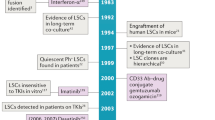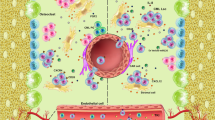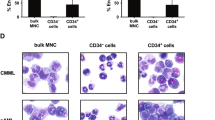Abstract
Although chronic myeloid leukemia (CML) is now defined on the basis of the presence of the BCR-ABL1 fusion gene, which may or may not be the initial genetic event that triggers the inappropriate expansion of the myeloid cell mass, CML, similar to other leukemias, is in fact clinically heterogeneous. The biological basis for this heterogeneity is unknown. Here, we summarize some of the data illustrating this heterogeneity and speculate about possible mechanisms that may cause it. It could, for example, be intrinsic in the leukemia stem cell or could be related to some aspect of the patient's response to the leukemia.
This is a preview of subscription content, access via your institution
Access options
Subscribe to this journal
We are sorry, but there is no personal subscription option available for your country.
Buy this article
- Purchase on Springer Link
- Instant access to full article PDF
Prices may be subject to local taxes which are calculated during checkout

Similar content being viewed by others
References
Fialkow PJ, Martin PJ, Najfeld V, Penfold GK, Jacobsen RJ, Hansen JA . Evidence for the multistep origin of chronic granulocytic leukemia. Blood 1981; 58: 158–163.
Zaccaria A, Testoni N, Valenti AM, Luatti S, Tonelli M, Marzocchi G et al. Chromosome abnormalities additional to the Philadelphia chromosome at the diagnosis of chronic myelogenous leukemia: pathogenetic ands prognostic implications. Cancer Genet Cytogenet 2010; 199: 76–80.
Minot GR, Buckman TE, Isaacs R . Chronic myelogenous leukemia: age incidence, duration and benefit derived from irradiation. J Amer Med Ass 1924; 82: 1489–1494.
Goldman JM, Lu DP . New approaches in chronic granulocytic leukemia—origin, prognosis and treatment. Seminars Hematol 1982; 19: 241–256.
Savage DG, Szydlo RM, Goldman JM . Clinical features at diagnosis in 430 patients with chronic myeloid leukaemia seen at a referral centre over a 16-year period. Brit J Haematol 1997; 96: 111–116.
Sokal JE, Cox EB, Baccarani M, Tura S, Gomez GA, Robertson JE et al. Prognostic discrimination in ‘good’ risk chronic granulocytic leukemia. Blood 1984; 63: 789–799.
Roy L, Guilhot J, Krahnke T, Guerci-Bresler A, Druker BJ, Larson RA et al. Survival advantage with imatinib compared with combination interferon–α in chronic phase chronic myelogenous leukemia: historical comparison between two phase 3 trials. Blood 2006; 108: 1478–1484.
Marin D, Ibrahim AR, Goldman JM . European Treatment and Outcome Study (EUTOS) score for chronic myeloid leukemia still requires more confirmation. J Clin Oncol 2011; 29: 3944–3945.
de Lavallade H, Apperley JF, Khorashad JS, Milojkovic D, Reid AG, Bua M et al. Imatinib for newly diagnosed patients with chronic myeloid leukemia: incidence of sustained responses in an intention-to-treat analysis. J Clin Oncol 2008; 26: 3358–3363.
Hochhaus A, O’Brien SG, Guilhot F, Druker BJ, Branford S, Foroni L et al. Six year follow-up of patients receiving imatinib for the first-line treatment of chronic myeloid leukemia. Leukemia 2009; 213: 1054–1061.
Apperley JF . Part I Mechanisms of resistance to imatinib in chronic myeloid leukaemia. Lancet Oncol 2007; 8: 1018–1029.
Gordon MY, Marley SB, Apperley JF, Marin D, Kaeda J, Szydlo R et al. Clinical heterogeneity in chronic myeloid leukaemia reflecting biological diversity in normal persons. Brit J Haematol 2003; 122: 424–429.
Ng KP, Hillmer AM, Chuah C, Juan WC, Ko TK, Teo AS et al. A common BIM deletion polymorphism mediates intrinsic resistance to tyrosine kinase inhibitors in cancer. Nat Med 2012; 18: 521–528.
Radich JP, Dai H, Mao M, Oehler V, Schelter J, Druker B et al. Gene expression changes associated with progression and response in chronic myeloid leukemia. Proc Nat Acad Sci USA 200: 2794–2799.
Oehler VG, Yeung KY, Choi YE, Bumgarner RE, Raftery AE, Radich JP et al. The derivation of diagnostic markers of chronic myeloid leukemia progression from microarray data. Blood 2009; 114: 3292–3298.
Yong A, Szydlo RM, Goldman JM, Apperley JF, Melo JV . Molecular profiling of CD34+ cells identifies low expression of CD7 along with high expression of proteinase 3 or elastase as predictor of long survival in patients with CML. Blood 2006; 107: 205–212.
McWeeney SK, Pemberton LC, Loriaux MM, Vartanian K, Willis SG, Yochum G et al. A gene expression signature of CD34+ cells to predict major cytogenetic response in chronic-phase chronic myeloid leukemia patients treated with imatinib. Blood 2010; 115: 315–318.
Florean C, Schnekenburger M, Grandjennete C, Dicato M, Diederich M . Epigenomics of leukemia: from mechanisms to therapeutic applications. Epigenomics 2011; 3: 581–609.
Strathdee G, Holyoake TL, Sim A, Parker A, Oscier DG, Melo JV et al. Inactivation of HOXA genes in myeloid and lymphoid malignancy is frequent and associated with poor prognosis. Clin Cancer Res 2007; 13: 5048–5055.
San Jose-Eneriz E, Agirre X, Jimenez Velasco A, Cordeu L, Martín V, Arqueros V et al. Epigenetic down regulation of BIM expression is associated with reduced optimal responses to imatinib treatment in chronic myeloid leukemia. European J Cancer 2009; 45: 1877–1899.
Dunwell T, Hesson L, Rauch TA, Wang L, Clark RE, Dallol A et al. A genome-wide screen identifies frequently methylated genes in haematological and epithelial cancers. Mol Cancer 2010; 9: 44–4.
Jelinek J, Gharibyan V, Estecio MRH, Kondo K, He R, Chung W et al. Aberrant DNA methylation is associated with disease progression, resistance to imatinib and shortened survival in chronic myelogenous leukemia. PLoS One 2011; 6: e22110.
San Jose-Eneriz E, Roman-Gomez J, Jimenez-Velasco J, Garate L, Martin V, Cordeu L et al. Micro-RNA expression profiling in imatinib resistant chronic myeloid leukemia patients without clinically significant ABL1-mutations. Mol Cancer 2009; 8: 69.
Polakova KM, Lopotova T, Klamova H, Burda P, Trnìnỳ M, Stopka T et al. Expression pattern of microRNAs associated with CML phases and their disease related targets. Mol Cancer 2011; 10: 41–54.
Hasford J, Pfirrmann M, Hehlmann R, Allan NC, Baccarani M, Kluin-Nelemans JC et al. A new prognostic score for survival of patients with chronic myeloid leukemia treated with interferon alfa. J Nat Cancer Inst 1998; 90: 850–858.
American Association of Cancer Research Epigenome Task Force and the European Union, Network of Excellence, Scientific Advisory Board. Moving AHEAD with an international epigenome project. Nature 2008; 454: 711–755.
Author information
Authors and Affiliations
Corresponding author
Ethics declarations
Competing interests
JMG and DM received financial support from Novartis and Bristol-Myers Squibb. JMG has also received consulting fees from Ariad Pharmaceuticals and lecture fees from Amgen Inc. MG and AB have no relevant financial support to disclose.
Additional information
This article was published as part of a supplement that was supported by Novartis, MSD Italia, Roche, Celgene, GlaxoSmithKline, Sanofi, Gilead, Adienne, Italfarmaco, Pierre Fabre Pharmaceuticals with an unrestricted educational contribution to AREO—Associazione Ricerche Emato-Oncologiche (Genoa) and AMS—Associazione Malattie del Sangue (Milan) for the purpose of advancing research in acute and chronic leukemia.
Rights and permissions
About this article
Cite this article
Goldman, J., Gordon, M., Bazeos, A. et al. Biology of CML stem cells: the basis for clinical heterogeneity?. Leukemia Suppl 1 (Suppl 2), S43–S45 (2012). https://doi.org/10.1038/leusup.2012.23
Published:
Issue Date:
DOI: https://doi.org/10.1038/leusup.2012.23
Keywords
This article is cited by
-
Stem cell maintenance and disease progression in chronic myeloid leukemia
International Journal of Hematology (2013)



